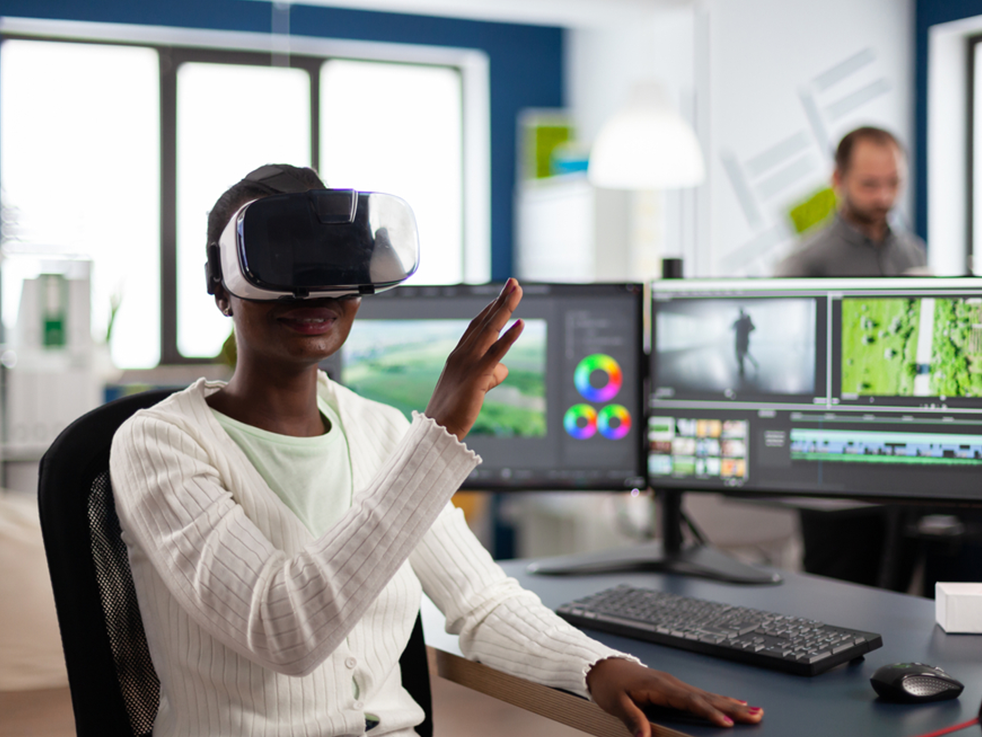What will future classrooms look like? Extended reality is key:
Discover how XR is revolutionizing practical learning methodologies

Have you ever watched a toddler use a mobile device? They know how to swipe, play videos, and take photos even if they can’t yet speak in full sentences. And they adore video filters that turn them into astronauts, dolphins, and monsters – a simple demonstration of extended reality (XR).
What does the future of the classroom look like for these young technologists when they get to college? With more than 23 million jobs expected to incorporate XR by 2030 according to Forbes, it’s a safe bet most students are eager to test new ways of consuming information. An effective curriculum weaves XR application of textbook concepts into the semester, enabling students to try new skills today.
So, how can your school incorporate XR (including virtual reality and augmented reality) into your educational ecosystem?
Where fantasy becomes reality
We’ll get there. But first – what are all these illusory realms?
- Virtual reality (VR) offers the ability to enter a synthetic environment created by a computer.
- Augmented reality (AR) overlays content to enhance the real world.
- Mixed reality (MR) brings immersion, interaction, and information to the forefront, enabling the virtual and real worlds to exist simultaneously.
XR is an umbrella term that blends the aforementioned realities together, creating an experience that’s so lifelike it blurs the boundary between make believe and the physical world. New York Yankees broadcaster Michael Kay famously bellowed, “Derek Jeter: where fantasy becomes reality!” when the shortstop hit a walk-off single in his final game at Yankee Stadium – a phrase that also concisely describes XR.
The best example of XR is the wildly popular mobile game Pokémon GO, in which players chase virtual characters through school grounds and shopping centers. Sure, XR is fun. But practical XR initiatives could revolutionize the way aspiring young professionals prepare for their careers – even if they don’t plan to earn a living nabbing rare creatures.
What can XR do for students?
The age-old ritual of high school juniors using school breaks to tour a slew of college campuses may be winding down. Students can now virtually tour prospective schools, enabling them to limit in-person visits to their top contenders. And athletic recruits can start working with their college coaching staff as soon as they sign a letter of intent. XR enables staff to teach athletes to improve their swings and throwing motions regardless of physical proximity.
Once matriculated, the opportunities for higher education students to leverage XR expand exponentially. Imagine a medical student being able to practice brain surgery without operating on a patient, or a would-be pilot learning to safely land a plane without the inherent dangers of flight. Mastering a trade in a low-stakes (yet realistic) environment is cost-effective and less stressful for novices. Aspiring architects can construct buildings without laying a single brick, and future construction workers can learn to operate machinery without ever climbing into the cab of a crane.
These skill sessions offer another benefit – internship opportunities. Technology-savvy students can create XR content, while marketing students can develop materials about on-campus programs.
Leveling up
Creating XR-fueled offerings requires schools to create secure and swift digital environments. You’ll want to ensure your curriculum is compelling – but first, you’ll need the infrastructure, security protocols, and hardware to support your initiatives. This may include:
- 5G network and strong Wi-Fi throughout your campus (if your infrastructure is weak, consider solutions that don’t require Wi-Fi).
- Cloud-based infrastructure.
- XR headsets with barcodes or other identifiers to help you manage inventory.
- Charging and cleaning structures to ensure headsets are powered up and sanitized.
- Mobile device management platform.
- Software to power your XR projects.
- Staff to manage and care for the equipment.
Once you have the proper infrastructure, ensure your faculty understands how to create effective XR lessons. SHI can help you identify the right professional development programs for your staff, paving the way for innovative teaching methodologies that excite your students.
Our grants team can highlight available funding sources for equipment and curriculum to keep your project within budget. We’ll even help you draft an effective application.
The future is now
We spent our summer vacation helping schools implement transformational XR initiatives for the fall semester. From working with a university to convert a historic building into a future-focused and boundary-breaking technology hub to helping a customer implement VR headsets to drive STEM initiatives and aid English as a Second Language (ESL) learners, we’ve witnessed the power of XR in the classroom.
And XR could help illuminate the next pathway for your student populace, too. Could your school enhance outcomes next semester by using XR to:
- Teach medical students how to locate a vein for injections?
- Provide teaching majors a virtual classroom for pedagogical practice prior to student teaching?
- Enable aspiring engineers to perform mechanical work on complex machinery?
- Send biologists on an exploratory trip under the Pacific Ocean to study a particular plant varietal?
SHI has the expertise and partner relationships to help you create limitless learning environments. Let’s work together to increase student engagement, reduce costs, and transform your classrooms with a multisensory XR initiative. Connect with our education strategists to get started today.




